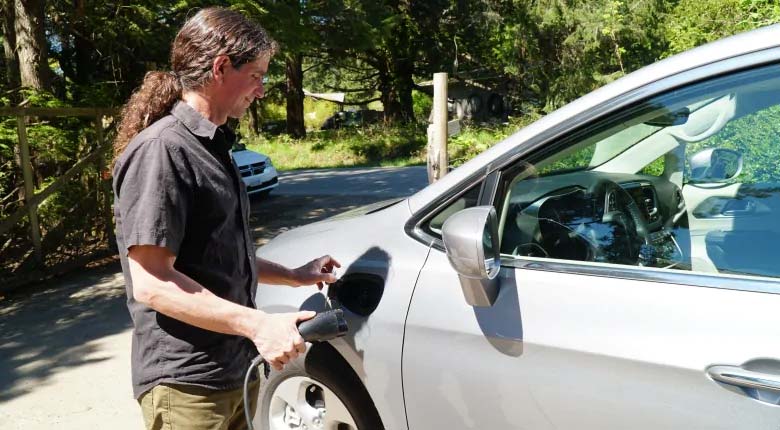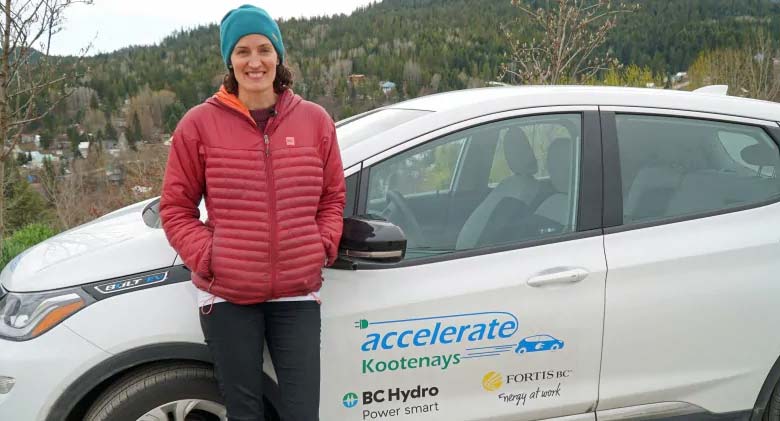Get news, updates and special invites from Transition Salt Spring. Join our mailing list.
This is a group for individuals (and organizations) interested in promoting the use of Electric Vehicles on Salt Spring Island.
The Salt Spring Island EV Group is for people who drive or ride electric vehicles, and for people who aspire to join the ranks of 'juiced riders'.
We have the largest per-capita ownership of Electric Vehicles in the country with more people plugging in every day.
Transition Salt Spring supports the EV revolution on the island by sponsoring free public charging stations in Ganges and around the island, for use by donation.
New Government rebate programs make buying an EV easier!"
https://www.cbc.ca/news/canada/federal-rebate-electric-car-1.5117934
For additional information
please visit ssi-ev.ca
Federal rebates for electric cars kick in with increased price limit.
Experts say government incentives help drive electric-car purchases
The Canadian Press · Posted: May 01, 2019 6:10 AM ET | Last Updated: May 1

The Chevrolet Bolt, one of Canada’s most popular electric car, is among the vehicles eligible for federal rebates that came into effect Wednesday. (Duane Burleson/Associated Press)
The rebates, announced in the last Liberal budget, will take up to $5,000 off the cost of electric vehicles, and $2,500 off plug-in hybrids, but they initially applied only to cars that cost less than $45,000.
Ottawa is raising that to $55,000 to increase the options a buyer can choose and still receive the rebate, which will allow some of the most popular cars, including the Tesla Model 3, to qualify. Tesla recently launched a cheaper Model 3 in Canada with a 150-kilometre-range to qualify for the previous limit, according to Electrek.
Nine electric cars and 13 plug-in hybrids are eligible, including the country’s second- and third-most popular electric cars, the Nissan Leaf and the Chevrolet Bolt.
Electric car experts say there is no doubt government incentives help drive electric-car purchases, noting when the new conservative government in Ontario killed a $14,000 rebate last year, electric-car sales in that province plummeted.
Road transportation accounts for as much as one-fifth of Canada’s emissions and the incentives are part of the federal government’s strategy to meet its international targets for reducing greenhouse-gas emissions to halt climate change.
Also see https://pluginbc.ca/incentives/vehicle-incentives/ for more incentives in BC.
EV Group gets more media coverage on CBC!
Our dedicated EV group was highlighted on the National last week along with an article on CBC news website. https://www.cbc.ca/news/techno
On Salt Spring Island, you can see the same issues keeping people across Canada from going electric
Even in Canada's electric-vehicle utopia, you can't miss what's hampering EV sales
David Common & Jill English · CBC News · Posted: May 04, 2019 4:00 AM ET | Last Updated: May 4

Salt Spring Island’s Jason Griffin didn’t have much choice when it came to buying a green vehicle for his tour business, because he needed something that could seat a group of people. (Jill English/CBC)
The cars pass almost silently, but you see hundreds of them on the streets. Salt Spring Island, Canada’s green magnet, claims to have the highest concentration of electric vehicle owners in North America.
And it stands to reason. The island, off the B.C. coastline, is just 27 kilometres end to end. A round trip is well within reach of even the EVs with the most limited range on the market. Temperate winters also mean EV batteries aren’t subject to extreme cold, which can reduce range by up to a quarter in Canada’s more frigid communities.
The provincial government also offers a rebate which, as of this month, can be combined with a new federal rebate of up to $5,000 to buy electric vehicles.
But while Salt Spring Island might seem like an EV utopia, not everyone who’d like a set of greener wheels is perfectly happy. And it’s for largely the same set of reasons keeping many Canadians in other parts of the country from letting go of gasoline-powered transportation.
Slim selection

Salt Spring Island resident Bob Wray unplugs his electric vehicle after grocery shopping. (Glen Kugelstadt/CBC)
Size matters in the car-buying environment, and for those seeking zero emissions there’s currently little available beyond small cars.
Need to haul a lot of material to work or a bunch of kids to their game? For those who need more seats or bigger cargo capacity, there’s just one model to choose from in Canada at the moment when it comes to affordable electric vehicles.
“With my business, it’s all about how many people I can get in the van and sell more seats to make it financial viable,” says Jason Griffin, who runs a tour business for visitors to Salt Spring.
The minivan he bought, “was my only real option for a vehicle this size,” and it isn’t purely electric. The plug-in hybrid Chrysler Pacifica runs on an electric motor for 50 to 100 km until the battery depletes, and then a gasoline engine takes over.

Griffin says he plans his trips around the short 50 km electric range of his hybrid van, so it’s sufficient for his tour company’s needs. (Jill English/CBC)
Mind you, Griffin plans his trips and charging stops around that to maximize his electric mileage. He says he still has the same tank of gas in the van that was there when he bought it nine months ago.
Manufacturers are well aware of the demand for larger and more diverse designs, and they’re racing to broaden their EV product lines.
Hyundai has introduced a small electric five-seater SUV called the Kona, joining Tesla’s much larger (and more expensive) Model X. Kia has a comparable model in the new Niro.
Meanwhile, both Tesla and Ford are working on a pick-up truck that they say will have extended electric-powered driving range.
Persuading the skeptics

On Salt Spring, where distances are relatively limited, few EV drivers have major worries about how far their cars can go between charges. But buyers still need to keep the range of EVs in mind when it comes to catching a ferry for a road trip beyond the island.
Likewise, available range is a key factor in persuading drivers across the country to buy electric, according to surveys conducted by the Canadian Automobile Association (CAA).
Still, as EV technology improves with each new model year, ranges are expanding and making this less of a concern for potential buyers.
Jim Standen of the Salt Spring Island EV group says his community of 10,500 has more than 200 electric vehicles on the roads. (Jill English/CBC)
“People talk about range anxiety,” says Jim Standen of the Salt Spring Island EV group. “I think a lot of the comments were fair four or five years ago, but the world is constantly changing — and it’s constantly changing in the direction of more electric transportation.”
While Teslas remain the benchmark for extended range, five other models now exceed 400 km. For most drivers, most of the time, that’s more than enough for daily use, allowing overnight charging at home (typically at a cost under $3 for a full charge).
The challenge for EV proponents has been getting that message out to the average car buyer.
Most sales of electric vehicles in Canada are happening in cities, where typical daily commutes are well within the range of all available models.
But those sales — even with rapid growth — remain minuscule. In the United States, 50,000 EVs are sold each month, but that represents 2.1 per cent of all new vehicle sales. Canadian bought 35,000 EVs in the year to September 2018 and the market share is similarly small, though in jurisdictions with rebates the sales are considerably stronger.
In rural areas, it can be more challenging to convince skeptical drivers to go electric.

Jen Grebeldinger of B.C.’s Community Energy Association will travel around the Kootenays this summer offering test drives for rural residents who are considering an electric vehicle. (Jill English/CBC)
“People who live in Northern B.C. are driving 100,000 km in two years for business and you just incorporate charging into your lifestyle — just like you did when you incorporated getting gas in your lifestyle,” explains Jen Grebeldinger of the EV showcase.
She notes there’s now an extensive network of roadside chargers across the province — and much of the country — with far more planned. While more are needed, she says, networks of chargers are helping to build the case for EVs.
“They make sense everywhere if it fits in your lifestyle. If you’re driving on highways and in-and-around town, an electric car can do that very safely and very comfortably.”
Cost
Price remains a challenge, though, with electric vehicles starting at $35,000.
Grebeldinger predicts price parity with gas vehicles could occur as soon as three years from now, but at the moment the sticker price of an EV can be a lot for a prospective buyer to bite off.
Helping to offset that up-front cost, the big selling point of EVs besides the environmental benefits is a savings estimated at around $2,000 a year in operating expenses for people who are charging instead of fueling up. Although for many EVs, that means five to seven years of driving before the investment of paying more for electric pays off in gas savings.
“It’s not yet cost-effective at this point for me,” electric vehicle owner Mike Greene admitted at a recent rural EV showcase in Rossland, B.C.
Mind you, Greene traded in his 1997 Honda Civic for a 2018 Tesla Model 3. He’s entered the EV market near the top.

Mike Greene brought his Tesla Model 3 to the Accelerate Kootenays EV showcase in Rossland, B.C. (Glen Kugelstadt/CBC)
Greene picked up his car months ago, before this week’s new federal rebate kicked in. Tesla has reduced the price of its most basic Model 3 to squeak in under the federal rebate program’s price limit ($44,999), but it has done so by limiting that model of car’s range to 150 km, well below its standard.
It’s unlikely consumers will buy that model with its limited range and there are reports Tesla does not offer expanded range on that model. However, as the base model qualifies for the federal rebate, consumers can buy the $53,700 Tesla with 350 km of range and still get the rebate.
At the EV showcase, the curious flocked to look at Greene’s Tesla, one of five in Rossland, B.C., a town of 4,000 framed by snow-capped mountains. Because of its isolation, at least two hours over mountain passes to the nearest major centre, the questions are specific.
“What’s the longest trip you’ve been on in this?” one person asks.
“Vancouver,” Greene responds. “Those would have been about 700 km trips.”
He says it took three 20-minute charges along the route.
So far, Greene says he’s had no reason to rethink his decision to buy an EV.
“Had it six months, no regrets.”
Find us on Facebook and stay in the loop!
EV News
Sorry, we couldn't find any posts. Please try a different search.
